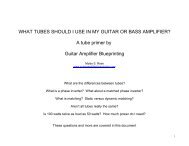a tube primer for guitar and bass players - Guitar Amplifier Blueprinting
a tube primer for guitar and bass players - Guitar Amplifier Blueprinting
a tube primer for guitar and bass players - Guitar Amplifier Blueprinting
Create successful ePaper yourself
Turn your PDF publications into a flip-book with our unique Google optimized e-Paper software.
The proper way to do this, is first install your bias probe on one of the old <strong>tube</strong>s, <strong>and</strong> set it’s level to the lowest possible milliamp draw. You<br />
may also just take your meter on the DC scale (another reason <strong>for</strong> a separate meter), <strong>and</strong> set this to the HIGHEST negative voltage. This<br />
means that –52 volts is the more preferred value than –49 volts as an example.<br />
Now, you can remove the old <strong>tube</strong>s with the amp off, install the new ones, <strong>and</strong> work up to the proper idle dissipation target.<br />
6L6 <strong>and</strong> 5881 <strong>tube</strong>s come in ranges from 19 watts to 30 watts. A KT-66 may have the same rating <strong>and</strong> be interchangeable with a 6L6, but<br />
in the same circuit, it may draw 10 more milliamps at load, so it’s bias may be very different than a 6L6.<br />
Different 6550 <strong>tube</strong>s <strong>and</strong> KT88 <strong>tube</strong>s may also vary.<br />
If you have something like Groove Tubes, you will not have to rebias if you use the SAME TUBE OF THE SAME RATING after properly<br />
setting the bias the first time. If the <strong>tube</strong> type changes though, a rebias is advised. “Same <strong>tube</strong>” here means just that. If you had a 6L6<br />
Svetlana, <strong>and</strong> you changed to a 6L6 JJ <strong>tube</strong>, these are NOT the same, even though both 6L6 <strong>tube</strong>s. Same <strong>tube</strong> means the same family,<br />
type, <strong>and</strong> manufacturer.<br />
Cathode biased amps (Class A) are thought of as self biasing, <strong>and</strong> this is accurate to a certain degree. The amp maker is expecting a <strong>tube</strong><br />
within the original spec range to be used. Today, this varies more widely than ever be<strong>for</strong>e, <strong>and</strong> if a <strong>tube</strong> outside the “normal range” is<br />
used, the amp may run very hot, with <strong>tube</strong> life short at best, bad <strong>and</strong> harsh tone, <strong>and</strong> at worst, <strong>tube</strong> <strong>and</strong> output trans<strong>for</strong>mer failure. Using a<br />
<strong>tube</strong> with a mid range rating number, such as GT’s 4-7 ratings, will be the best choice in most cases. You can also use a bias tool (there<br />
are 9 pin adapters <strong>for</strong> EL-84 <strong>tube</strong>s) <strong>and</strong> check your dissipation too. Remember, in Class A amps, the <strong>tube</strong>s run close to or at 100% idle<br />
dissipation. If a <strong>tube</strong> has a maximum plate dissipation of 12 watts, such as an EL-84, a bit of math will be needed to be done to see what<br />
milliamp value should be as the maximum. If this is too high, just go to a lower range <strong>tube</strong>. It is that easy. As an example, if you have a<br />
#7 <strong>tube</strong> in an amp <strong>and</strong> it is running too hot (high millamps value), drop to a 5 or 6 <strong>and</strong> the value will drop into a more proper range. This is<br />
also a cool trick on fixed bias class A/B amps such as Hiwatt <strong>and</strong> Mesa Boogie amps. Mesa amps like mid range <strong>tube</strong>s in the 4-7 range.<br />
Elsewhere in this document is a conversion scale to covert the Mesa <strong>and</strong> Fender color codes to rating numbers. Mesa amps typically are<br />
OVERBIASED, meaning they run cold. This is part of the reason that many feel they sound a bit grainy. On my own Mark 1, the stock idle<br />
with Mesa mid color (range) <strong>tube</strong>s is only 38%. What we are looking <strong>for</strong> generally is 50-70%. Using a GT #7 <strong>tube</strong> in the amp brings this<br />
into proper range. Cold running (overbiased) amps sound grainy, lack power, <strong>and</strong> definition. Underbiased amps (hot running) amps sound<br />
harsh, do not per<strong>for</strong>m as well at low <strong>and</strong> medium levels, <strong>and</strong> have shorter <strong>tube</strong> life.<br />
48



